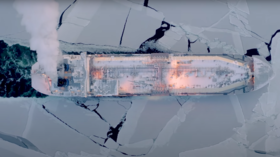‘Breaking ice to move gas’: As Russian tanker-icebreaker duo complete milestone Arctic voyage, climate activists side with ice

Following a nuclear-powered icebreaker, a Russian tanker has sailed through the frigid Northern Sea Route for the first time ever in February. “Won’t somebody think of the poor ice?”, climate-conscious commenters shouted.
The Christophe de Margerie, a liquefied natural gas tanker operated by Russian shipping firm Sovcomflot, made history this week when it docked at the remote Arctic terminal of Sabetta, after sailing through the normally ice-locked Northern Sea Route (NSR) from Jiangsu in China. Traveling solo through the Bering Strait, it then followed a nuclear icebreaker, the 50 Let Pobedy, along Russia’s northern coast until it reached Sabetta on Friday.
The journey marked the first time a tanker has sailed the route in February, “and confirms that year-round safe navigation is possible along the entire length of the Northern Sea Route,” Sovcomflot CEO Igor Tonkovidov said during a meeting with Russian officials last week. Russian Deputy Prime Minister Yury Trutnev predicted that year-round shipping along the route could more than double by 2024.
A gas tanker & icebreaker made it from China to Yamal in the 1st transit of the Northern Sea Route in February, "confirming that year-round safe navigation is possible," Russia says. There's no multi-year ice left there. @BarentsNewshttps://t.co/57fCekHYZLpic.twitter.com/PgO45fjN9V
— Alec Luhn (@ASLuhn) February 21, 2021
The route, which cuts the East Asia to Europe shipping time by nearly half, was previously off-limits for the first few months of the year due to thick ice, but the changing climate has dislodged some of this ice and made the NSR a viable and competitive shipping route.
Also on rt.com New year-round port to link Russian Arctic sea route with Asia in 2025However, some observers took issue with the idea of a Russian ship “literally breaking apart ice to move gas.” Even though ice-breaking ships have been used in polar regions since as early as the 11th century, the climate crowd still sounded the alarm.
I cannot think of a more on the nose metaphor for how we are fucking the planet than literally breaking apart ice to move gas. https://t.co/OoBmxdiIa6
— Dr Benjamin Janaway 💙 (@drjanaway) February 21, 2021
This is just the start of something very, very dangerous. In a press release announcing the voyage, the company said it has an order for "18 new-generation icebreaking LNG carriers" to transport gas from a project that could produce 20 million tons per year https://t.co/JgErHepxTk
— Brian Kahn (@blkahn) February 21, 2021
Oh no. Now full steam ahead to see what else they can destroy. No more ice. Fuck. https://t.co/oTukvVInVO
— cynthia w Nelson (@cindian1) February 21, 2021
Their icebreaker-induced meltdown aside, the reason the route is traversable is actually due to higher temperatures. Previously, some ice along the passage would go years without thawing, effectively sealing the route off entirely. On its most recent voyage, the Christophe de Margerie encountered no multi-year ice at all – a sign that the region is indeed warming up.
The Northern Sea Route through the Arctic north of Siberia is now open. In February.There is no multi-year ice left there anymore.We are in a climate emergency. https://t.co/HwOSSkD6o7
— Eric Holthaus (@EricHolthaus) February 21, 2021
Amid rising temperatures, some activists have called for an end to fossil fuel use altogether. Climate campaigner and self-proclaimed “eco-socialist” Carola Rackete declared that “gas tankers should not even exist in the first place,” while another commenter demanded that Microsoft CEO Bill Gates intervene to save the planet (possibly by blocking out the sun, Mr. Burns style).
The point is: gas tankers should not even exist in the first place. https://t.co/uNKbeXIml9
— Carola Rackete (@CaroRackete) February 21, 2021
Bill Gates, you are our only hope. https://t.co/RNWk7rPC0H
— Camus is cool I guess🟢 (@MaryLouBearhig) February 21, 2021
Concerns about the planet notwithstanding, geopolitical tensions look set to heat up long before the ice disappears. As the Christophe de Margerie left Jiangsu in late January, more than 1,000 US Marines landed in Scandinavia for Arctic warfare training. Several weeks earlier, then-US Navy Secretary Kenneth Braithwaite said the American sailors would increasingly be making their presence known. “You will see the navy operating again in a more permanent manner above the Arctic Circle,” he said, adding that the US will “operate more assertively” to challenge Russia’s claims in the region.
Also on rt.com Creating conditions for a very frozen conflict? US Navy to step up patrols in frigid Arctic waters off Russia’s northern bordersLike this story? Share it with a friend!














